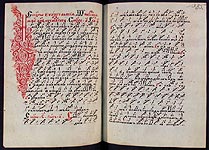Notated Collection of Vocal Music.
70s. 17th cent. [ Trinity-St. Sergius Monastery]. Bookbinder: Vasily Glebov
Q (195ı150) 615+III leaves.
Paper. Ink, cinnabar.
It is written in a semi-uncial script by several hands (change of handwriting on fols. 169r, 182r, 258v, 384v, 392r, 401v, 565v, 569r, 583r, 596r, 609r).
Znamenny notation without red-ink marks (known as the Shaidurov's marks) and black line-signs (the priznaki of Mezenets).
There are ornamental head-pieces with plant-motifs in the Early Printed style in ink. Margins on fols. 1r, 258r, 401r are decorated with pictures of birds at the top. There are initials with plant-motifs in cinnabar (fols. 1v, 182r, 384v) and initials with plant-motifs in the Early Printed style in ink (fols. 258v, 401v). Headings are written in cinnabar with use of ligatures.
The manuscript belonged to the head of the choir of the Kirillo-Belozersky Monastery Hierodeacon Grigory Zhernov. He was born in the Belozersky district in the family of the strelets (guardsman) Nikita Timofeev, a son of Koneval. After a while, Grigory became a monk of the New-Jerusalem Monastery of the Resurrection, which was founded by Patriarch Nikon in 1656. It is well known, in 1666 Nikon was exiled to the Ferapontov convent to the east from the Kirillo-Belozersky Monastery. Probabely at the same time, Grigory Zhernov bacame the head of the choir of the Kirillo-Belozersky Monastery. He payed the deepest respect to the patriarch and referred to him as the "former" "His All Holiness Nikon the Patriarch of Moscow and all Russia" even after Nikon's deposition. Zhernov commisioned several collections of vocal music, among which was this manuscript. The ownership inscription records that it was bound in 1674 by Vasili Glebov at the Trinity-St Sergius Lavra. The other note says that the Moscow citizen Andrey Martinov, subordinate to Zhernov, signed the manuscript. This note contains the encrypted last name of Zhernov which is written as Khemposh with use of a simple substitution cipher, where some consonants were substitutes for others in the message. It may be assumed, that the codex consisting of several books of vocal music and single sets of hymns, written by several hands, was created and compiled at the Trinity-St Sergius Lavra, in the same place where it was bound.
Almost all books of vocal music, necessary for liturgical services, except the Monthly Sticherarion, were included in the manuscript by request Grigory Zhernov. The text was supplied with numerous instructions, as well as notes about differences between the Russian way of singing and Greek, Serbian or Bulgarian methods. The copiler consulted both contemporary printed books and ancient manuscripts and told of this in his commentaries on the text. He made use of many divers sources in the creation of this collection. A wide range of hymns with the very different chants, borrowing from them, enabled him to represent a variety of church vocal music, its melodic richness.
In 1918 the manuscript came into the State Public Library along with the other materials from the library of the Kirillo-Belozersky Monastery.
Shelfmark: –Õ¡. Ë.-¡ÂÎ. 632/889.





